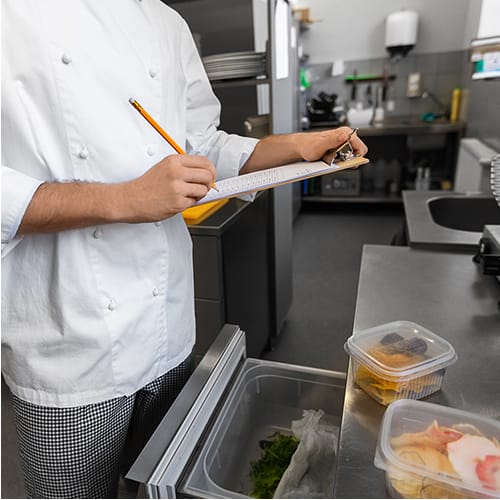
A foodborne illness outbreak is one of the most serious issues a restaurant can face. There are many types of foodborne illnesses, and their symptoms range from presenting minor discomfort to having severe health consequences. If your restaurant is identified as the source of a foodborne illness outbreak, your response is critical. Not only does it ensure that no one else is affected, it helps prevent future outbreaks. Failure to handle outbreaks properly can erode trust in your management and your business, leading to lost customers and potential legal consequences.
What Is a Foodborne Illness Outbreak

A foodborne illness outbreak occurs when two or more people experience similar symptoms after consuming the same food or drink. When such an outbreak occurs, the Food and Drug Administration (FDA) launches an investigation, the primary goal of which is to control the outbreak and prevent more individuals from falling ill. There are two main types of foodborne illness outbreaks: apparent outbreaks and confirmed outbreaks.
- Apparent outbreaks: An apparent foodborne illness outbreak, sometimes referred to as a probable outbreak, is when a specific food or meal is suspected as the cause. In this scenario, person-to-person transmission or other exposures cannot yet be ruled out as potential sources of illness.
- Confirmed outbreaks: A confirmed foodborne illness outbreak occurs when laboratory testing results conclusively show that the suspected food or drink was indeed the cause of the illness experienced by those affected.
What Causes Foodborne Illness?
Understanding the common causes of foodborne illness is crucial in preventing outbreaks and maintaining a safe environment for all. Although many factors play a role in the communication of foodborne illnesses, there are five main and most common causes:
- Improper holding temperatures: Keeping food at incorrect holding temperatures exposes it to the temperature danger zone (41 - 135 degrees Fahrenheit), where bacteria multiply rapidly.
- Inadequate cooking: Failure to cook food to the correct temperature or doneness can leave harmful bacteria alive and capable of causing illness. Proper cooking techniques ensure food is safe for consumption and free from pathogens.
- Cross-contamination: Contaminated utensils, food prep surfaces, or equipment can transfer harmful bacteria to food, leading to foodborne illness. Implementing proper restaurant sanitation practices and preventing cross-contamination is essential in food safety protocols.
- Purchasing food from unsafe sources: Verify the certification and quality of food sources to ensure the safety of the products being used in food preparation.
- Poor personal hygiene: Employees who fail to practice proper handwashing techniques, neglect to wear gloves when necessary, or work while exhibiting symptoms of illness can contaminate food and contribute to the spread of foodborne pathogens.
What to Do During a Foodborne Illness Outbreak

During a foodborne illness outbreak, commercial establishments must take immediate action to protect the health and safety of patrons and staff. If you suspect your establishment may be the source of a foodborne illness outbreak, organize a swift and effective response. Stay familiar with the key steps involved in a foodborne illness outbreak plan to react appropriately.
1. Discontinue Operations and Gather Information
The first crucial step is to pause operations immediately. At this point, it is difficult to determine which food items are at risk and which are not, and continuing to serve customers poses a serious threat to public health. Even if you are reasonably sure that a specific ingredient or menu item is not the cause of the outbreak, you must err on the side of caution. Proper training will help minimize the impact and ensure compliance with health and safety regulations.
2. Do Not Discard Affected Food
You should not discard any of the foods or ingredients in question until a full investigation has been completed. The foods being served at the time of the outbreak, along with the equipment used to prepare them, provide critical clues when pinpointing the source of the issue. This food should be separated from all other food items in order to avoid cross-contamination. Additionally, the state of your kitchen and any other evidence in your establishment can be instrumental in identifying the exact cause of the outbreak.
Provide all relevant records related to the investigation, including purchasing documents, staff logs, the equipment used, kitchen cleanliness practices, and any other pertinent details that can shed light on the situation. Transparency is key in these situations, and withholding details can hinder regulatory authorities' ability to address the issue and may put more individuals at risk.
3. Notify Local Regulatory Authorities
Collaboration and cooperation with local authorities are paramount when managing crises, and you should contact necessary agencies as soon as you suspect an outbreak. In particular, your state or territorial department of health agency should be notified, as well as any other necessary organizations in your area. Be sure to carefully explain the situation in detail, providing all necessary information. In some instances, a foodborne illness outbreak can involve multiple establishments, making your account just one part of a larger story. By being honest and forthcoming with information, you not only assist regulatory authorities in their investigation but also play a critical role in safeguarding public health.
4. Comply with the Investigation
Authorities will investigate to identify the source of the outbreak, determine who has been affected, and assess the potential spread of the illness. They will likely provide you with a specific set of instructions to follow, which may include gathering records or allowing them access to your facility for inspection. Remember, the faster they can complete their investigation, the sooner they can take necessary actions to help those affected by the outbreak. This is where the training of you and your staff will come into play. Ensure everyone is well-versed in food safety best practices and understands the actions to take. By being prepared and knowledgeable, you can help the investigation progress smoothly and efficiently.
5. Wait For Approval to Resume Operations
Your business should not resume operations until you receive approval from all necessary authorities. The exact timeline of when you can reopen your establishment will vary depending on your restaurant location and the local laws and regulations you are subject to. Follow these guidelines carefully to avoid any potential legal ramifications and to protect the health of your patrons. While waiting for approval, use the feedback and guidance you have gathered throughout the outbreak investigation process. Reflect on the areas that may have contributed to the issue and implement necessary changes to improve your operating procedures.
Foodborne Illness Outbreak FAQ

The key to effectively managing such an event lies in knowledge and preparedness. To assist you in navigating through this critical issue, we have compiled a list of frequently asked questions regarding foodborne illness outbreaks.
How Is a Foodborne Illness Outbreak Confirmed?
During a foodborne illness outbreak, authorities conduct a thorough investigation to determine the root cause and prevent spread. Though the process can vary depending on your location, it typically analyzes three key data points: epidemiologic data, traceback data, and food testing data.
- Epidemiologic data: This data encompasses when the outbreak occurred, the symptoms experienced by those affected, and the potential source of the contaminated food. It helps identify who became ill, where they were affected, when they fell sick, and which organism could be responsible for the outbreak.
- Traceback data: Traceback data focuses on the supply chain. Authorities scrutinize documentation to trace the origin of the food in question and the companies involved in its distribution. This determines if the contaminated food originated from a specific source and if other businesses may also be affected by the outbreak.
- Food testing data: Through thorough testing, authorities can identify potential contaminants, pinpoint the specific food item responsible, and determine the type of illness at play.
What Is the Cost of a Foodborne Illness Outbreak?
Foodborne illness outbreaks cost the foodservice industry billions of dollars each year. The specific cost will depend on how many people were affected, the nature of the outbreak itself, how long the investigation lasts, and whether your establishment was following proper food safety practices. Direct costs to business owners as a result of an outbreak can include:
- Lost revenue: A business may need to close for testing and could lose customers due to negative publicity, resulting in lost revenue.
- Fines: Authorities can impose fines if your establishment is found to violate food safety regulations.
- Product recalls: An outbreak originating from a specific retailer or supplier may lead to a recall, necessitating you to dispose of ingredients you stocked up on. If you are not liable, the retailer might cover these costs.
- Rising insurance costs: Going through an outbreak can lead to an increase in your insurance premiums.
- Legal fees: If your establishment is found liable for the outbreak and customers were harmed, you may face lawsuits, resulting in legal fees.
What Foods are Most Likely to Cause a Foodborne Illness Outbreak?
Any food that is improperly cooked or held, as well as any food that has been contaminated by a sick food handler, can cause a foodborne illness outbreak. However, certain types of foods are more commonly associated with the issue. The list of foods includes:
- Raw or undercooked meat
- Raw or undercooked poultry
- Raw or undercooked seafood
- Shellfish
- Dairy products
- Raw produce
Back to Top
A foodborne illness outbreak is a serious problem that is all too common in the foodservice industry. It can happen to anyone, even if you try your best to avoid it. Should an outbreak occur in your establishment, the best you can do is prepare an effective response and handle the situation with care. By understanding what an outbreak is, what can cause it, and how to respond when one occurs, you can set yourself up to minimize the impact if you and your patrons are affected.





